When the Arabian peninsula was Northeast Africa(for The Anthropologist Among Us) - Culture - Nairaland
Nairaland Forum / Nairaland / General / Culture / When the Arabian peninsula was Northeast Africa(for The Anthropologist Among Us) (10304 Views)
Join African school of grassroots science: For Science Teachers. / Racialist Anthropologist Discussing Igbos, Please Contribute / New Face Of Central Africa For Cosmeic, What Do You Think (2) (3) (4)
| When the Arabian peninsula was Northeast Africa(for The Anthropologist Among Us) by RandomAfricanAm: 8:34am On Nov 25, 2013 |
Question: (For the anthropologist among us) 1. Do you think the desiccation of the Sahara could have pushed Africans farther then the Nile valley into the Arabian peninsula? 2. How accurate would you say this map is? 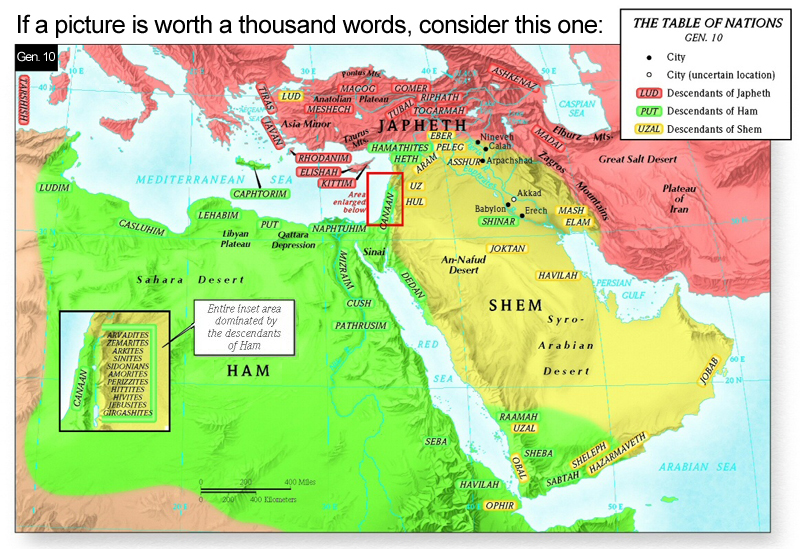  **Yes they are contradictory** Context: I've been moving away from the two terms Black and African. Not that there is anything necessarily wrong with them it's just that they tend to fall apart under close scrutiny. To be more precise, when used as delineators for sorting & grouping people the results tends to not be representative of what the terms Black and African Denote. The sorted group tends to fall under the connotation of those words which differ given different people, cultures, and politics. As a result and for the time being... When I say "Black people" I'm referring to a subset(undecided) of humanity that is tropically adapted(which is my delineator) independent of any genetic make up or place of birth/residence. When I say "African people" I'm referring to a subset of humanity that dwelled in and migrated out of the current day Sahara-Sahale region during it's green phase and subsequent Desertification. This includes the people they absorbed in the process of spreading across the continent & world. This is independent of birth place, politics, religion, culture, phenotype, or nationality.(because they are not the delineator) This is generally typified by the genetic presence of paternal PN2 and maternal L1, L2, L3 **These are not hard fast definitions it's simply were I'm at right now** As always when thinking about cultural groups I start by mentally moving through the movements of people until I get to the period under question then I stop and review what I have before me. The difference is that now I'm going to start doing it in the open instead of mentally.**I need to make a gif for this purpose** Prior to ejection from the Sahara: Africans have been in the sahale-Saharan area since at least around the aqualithic /green Saharan period. 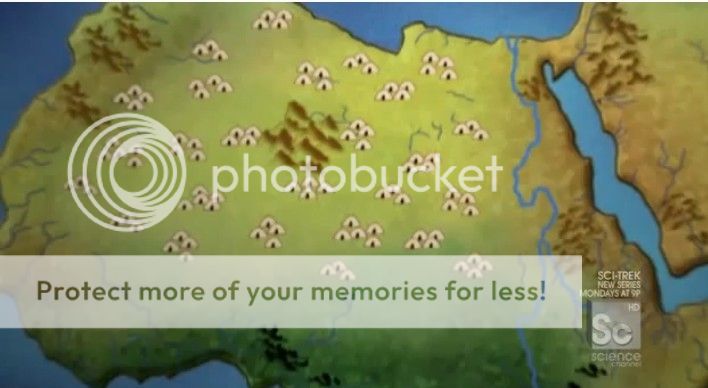 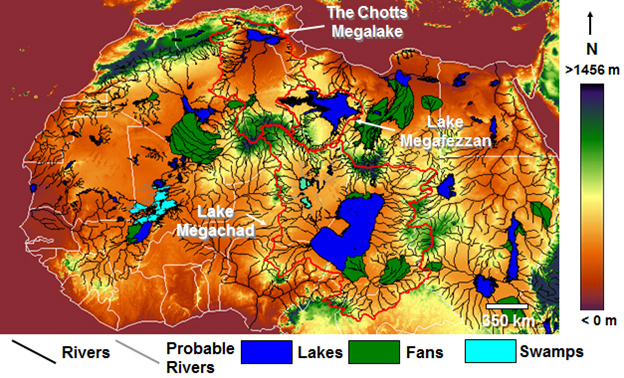 The occupation of the Sahara was one that shared certain material culture commonalities throughout such as barbed harpoons for fishing and wavy lined pottery for storage. [img]http://openi.nlm.nih.gov/imgs/rescaled512/2515196_pone.0002995.g007.png[/img] [img]http://mathildasanthropologyblog.files./2008/08/ten-pot.jpg[/img] 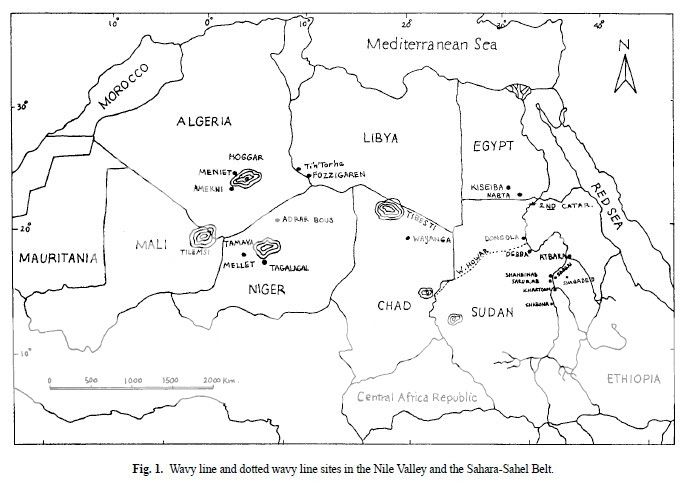 Ejection from the Sahara: Southward As the Sahara began to dry out the people began to be pushed out of and mashed between, the desert and forest belt in what is now called the Sahale, gathering primarily around lake chad creating and extending across the ancient sahale to Nile trade routs.  Trailing the river routs down into Cameroon and Nigeria were they would set the staging grounds for the later bantu migration to occur as the area becomes overpopulated from reproduction and further dessication in the north pushes more people south.  Ejection from the Sahara: Westward To the west they were pushed to the Niger bend and Southern Mauritania resulting in early population centers around Tichitt-Walata. 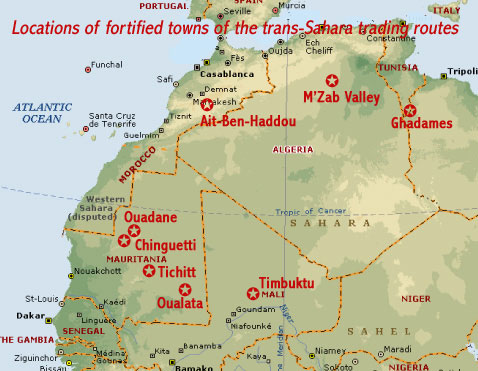  [img]http://img1.advisor.travel/f550x450px-9010136964c1ccca6c8cc6581580774.jpg[/img]    Tichitt-Walata and the Middle Niger: evidence for cultural contact in the second millennium BC **Further reading** http://www.yumpu.com/en/document/view/10874841/tichitt-walata-and-the-middle-niger-panafrican-association-of- Ejection from the Sahara: Eastward To the east they gathered around the Nile valley  "The evidence also points to linkages to other northeast African peoples, not coincidentally approximating the modern range of languages closely related to Egyptian in the Afro-Asiatic group (formerly called Hamito-Semetic). These linguistic similarities place ancient Egyptian in a close relationship with languages spoken today as far west as Chad, and as far south as Somalia. Archaeological evidence also strongly supports an African origin. A widespread northeastern African cultural assemblage, including distinctive multiple barbed harpoons and pottery decorated with dotted wavy line patterns, appears during the early Neolithic (also known as the Aqualithic, a reference to the mild climate of the Sahara at this time). Saharan and Sudanese rock art from this time resembles early Egyptian iconography. Strong connections between Nubian (Sudanese) and Egyptian material culture continue in later Neolithic Badarian culture of Upper Egypt. Similarities include black-topped wares, vessels with characteristic ripple-burnished surfaces, a special tulip-shaped vessel with incised and white-filled decoration, palettes, and harpoons... Other ancient Egyptian practices show strong similarities to modern African cultures including divine kingship, the use of headrests, body art, circumcision, and male coming-of-age rituals, all suggesting an African substratum or foundation for Egyptian civilization.. Source: Donald Redford (2001) The Oxford encyclopedia of ancient Egypt, Volume 3. Oxford University Press. p. 28 Resulting in the moving of people from the south founding the Nile valley civilizations of Kerma/kush and kemet(ancient egypt) [img]http://1.bp..com/-nzzzWlQL3OQ/To1qWz78fSI/AAAAAAAAACk/BZZ7-lXdnYw/s1600/kerma.gif[/img]    Early settlement Human populations settled in the Kerma Basin at a very early date, as evidenced by several Mesolithic and Neolithic sites. The earliest traces of a human presence in the region date back tens of thousands of years. From 7500 BC onward the archaeological remains become more significant: semi-buried dwellings, various objects and tools, and graves.[5] What’s clear is that Kerma’s civilisation emerged out of an ancient pastoral culture that had flourished in that part of Sudan since at least 7000 B.C. when the first settlements were established. Near Kerma, archaeologists have discovered one of the two oldest cemeteries ever found in Africa – dating back to 7500 B.C. – and the oldest evidence of cattle domestication ever found in Sudan or, indeed, in the Egyptian Nile Valley. Around 3000 B.C., a town began to develop near the Neolithic dwellings. Pre-Kerma (c. 3500-2500BC) No C-Group Phase Early Kerma (c. 2500-2050BC) C-Group Phase Ia-Ib Middle Kerma (c. 2050-1750BC) C-Group Phase Ib-IIa Classic Kerma (c. 1750-1580BC) C-Group Phase IIb-III Final Kerma (c. 1580-1500BC) C-Group Phase IIb-III Late Kerma – ‘New Kingdom’ (c.1500-1100?BC) ‘New Kingdom’ The Eco-Political Structure of Kerma Until recently, the Kerma civilisation was known only from the townsite and cemeteries of its metropolitan centre and smaller sites to the north, towards Egypt. However, recent survey and excavation work has identified many new sites south of Kerma, many located on channels of the Nile, now dry, which lay to the east of the modern course of the river. This pattern of settlement indicates a substantial population and for the first time provides us with some sort of context in which we can place Kerma itself. Survey work in advance of the Merowe Dam at the Fourth Cataract has confirmed the presence of Kerma sites at least as far upriver as the Abu Hamed/Mograt Island area.[1] Kerma was evidently a sizable political entity - Egyptian records speak of its rich and populous agricultural regions. Unlike Egypt, Kerma seems to have been highly centralized. It controlled the 1st to 4th Cataracts, which meant its domain was as extensive as ancient Egypt.[2] Numerous village communities scattered alongside fields of crops made up the bulk of the realm, but there also seems to have been districts wherein pastoralism (goat, sheep and cattle) and gold processing were important industries.[3] Certain Kerma towns served to centralize agricultural products and direct trade. Analysis of the skulls of thousands of cattle interred in royal Kerma tombs suggest that stock were sometimes brought vast distances, from far districts, presumably as a type of tribute from rural communities on the death of Kerma's monarchs. This parallels the importance of cattle as 'royal property' in other parts of Africa at later times. Only the centres of Kerma and Sai seem to have had contained sizable urban populations. Possibly further excavations will reveal other regional centres. At Kerma and Sai, there is much evidence of wealthy elites, and a class of dignitaries who monitored trade in merchandise arriving from far-off lands, and who supervised shipments dispatched from administrative buildings. Evidently Kerma played an important 'middle man' role in the trade of luxury items from the African interior to Egypt [4]   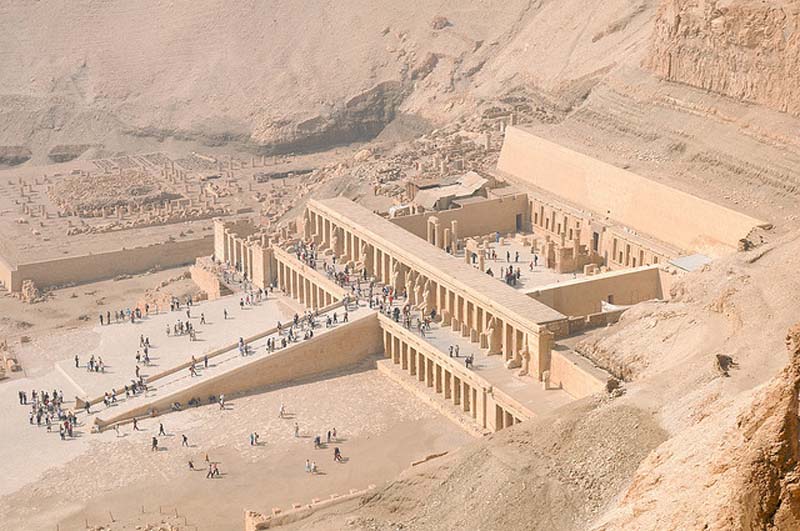 Ejection from the Sahara: Northward Subsequently moving into north Africa at a much later date 1000 BC - 100 AD ABSTRACT The Berber languages are relatively well-studied, and it is possible to explore their geographical extent today and in the past, and also reconstruct basic and culturalvocabulary which can be attributed to speakers of proto-Berber. However, there is a major problem reconciling this with textual and archaeological evidence. The proto-Berber we can reconstruct seems to be far to recent to match what we know from other evidence; indeed it seems to reach back to period as late as 200 AD. Textual evidence (and Canarian inscriptions) point to a period prior to 400 BC, while the most credible archaeological correlate would be the spread of pastoralism across the Sahara, pointing to the period 5-4000 BP. The paper explores this disjunction and suggests the underlying reason for it is massive language levelling in the period after 0 AD. In other words, the original speakers of Berber did indeed spread out westwards from the Nile Valley, 5-4000 years ago, but the diversity which evolved in this period was eliminated by a sociolinguistic processes which levelled divergent speech forms. Historical linguists have been wary of invoking such process until recently, but evidence is mounting for their importance in many and varied cultures, including China, Borneo and Madagascar. Hypotheses are evaluated to explain the Berber situation and it is suggested that a combination of the introduction of the camel and the establishment of the Roman limes were the key factors in creating this linguistic bottleneck. -Recent work by Roger Blench. http://www.rogerblench.info/Archaeology/Africa/Berber%20prehistory%202012.pdf ************ Ejection from the Sahara: Into Arabian peninsula But again how far would you say the Saharan population was pushed given the info at your disposal?   “From a genetic point of view, several recent genetic studies have shown that subSaharan genetic lineages (affiliated with the Y-chromosome PN2 clade; Underhill et al. 2001) have spread through Egypt into the Near East, the Mediterranean area, and, for some lineages, as far north as Turkey (E3b-M35 Y lineage; Cinniogclu et al. 2004; Luis et al. 2004), probably during several dispersal episodes since the Mesolithic (Cinniogelu et al. 2004; King et al. 2008; Lucotte and Mercier 2003; Luis et al. 2004; Quintana-Murci et al. 1999; Semino et al. 2004; Underhill et al. 2001). This finding is in agreement with morphological data that suggest that populations with sub-Saharan morphological elements were present in northeastern Africa, from the Paleolithic to at least the early Holocene, and diffused northward to the Levant and Anatolia beginning in the Mesolithic. Indeed, the rare and incomplete Paleolithic to early Neolithic skeletal specimens found in Egypt - such as the 33,000-year-old Nazlet Khater specimen (Pinhasi and Semai 2000), the Wadi Kubbaniya skeleton from the late Paleolithic site in the upper Nile valley (Wendorf et al. 1986), the Qarunian (Faiyum) early Neolithic crania (Henneberg et al. 1989; Midant-Reynes 2000), and the Nabta specimen from the Neolithic Nabta Playa site in the western desert of Egypt (Henneberg et al. 1980) - show, with regard to the great African biological diversity, similarities with some of the sub-Saharan middle Paleolithic and modern sub-Saharan specimens. This affinity pattern between ancient Egyptians and sub-Saharans has also been noticed by several other investigators..” --Ricaut and Walekens (2008) ‘Cranial Discrete traits) https://www.youtube.com/watch?v=YlSAEuIIYVY 1 Like |
| Re: When the Arabian peninsula was Northeast Africa(for The Anthropologist Among Us) by RandomAfricanAm: 1:00am On Nov 27, 2013 |
High atop a dusty plateau on the Arabian Peninsula, archaeologist Jeffrey Rose picked up a rock, saw something surprising, and started asking questions that could change history. His unusual discoveries in southern Oman help shape new theories about when early humans may have exited Africa, who those pioneers were, and what route they took on the first stage of their journey to every corner of the Earth. In the late 1990s geneticists identified mitochondrial DNA signatures suggesting that the first humans to leave Africa may have traveled through Ethiopia to Yemen and Oman. Scientists theorized they were beachcombers who followed the coastline. Rose arrived in the area, eager to test the theory that Arabia was the gateway out of Africa by searching for archaeological evidence. "We surveyed for years," he recalls. "Stone Age artifacts littered the landscape; virtually any place I stopped the car, I found a Paleolithic site. But none of it showed a connection to Africa; and along the coast we found no evidence of humans at all." [b]He and his international team of scientists returned to Oman in 2010, and on the final day of their surveying season, at the last site on their list, "we hit the jackpot." The find was a very specific stone tool technology used by the "Nubian Complex," nomadic hunters from Africa's Nile Valley. Nubian technology is a unique method of making spear points that was previously only known from North Africa. Rose's team ultimately discovered over a hundred workshop sites where these artifacts were manufactured en masse. "It was scientific euphoria," he describes. The Nubian origin and inland location of the discovery were equally unexpected. "We had never considered the link to Africa would come from the Nile Valley, and that their route would be through the middle of the Arabian Peninsula rather than along the coast," Rose notes. "But that's what the scientific process is all about. If you haven't proven yourself wrong, you haven't made any progress. In hindsight, the Nubian connection makes perfect sense. The Nile Valley and Oman's Dhofar region are both limestone plateaus, heavily affected by perennial rivers. It's logical that people moved from an environment they knew to another one that mirrored it.[/b] At the time when I'm suggesting they expanded out of Africa, southern Arabia was fertile grassland. The Indian Ocean monsoon system activated rivers, and as sand dunes trapped water, it became a land of a thousand lakes. It was a paradise for early humans, whose livelihood depended upon hunting on the open savanna." Accurately dating Rose's Nubian discovery was made possible by optically stimulated luminescence (OSL) technology, which can determine the last time a single buried grain of sand was exposed to light by measuring the amount of energy trapped inside of it. The technique revealed the tools to be 106,000 years old, exactly the same time the Nubian Complex flourished in Africa. This also means Rose's theory places the first exit from Africa much earlier than previously believed. "Geneticists have shown that the modern human family tree began to branch out 60,000 years ago. I'm not questioning when it happened, but where. I suggest the great modern human expansion to the rest of the world was launched from Arabia rather than Africa." Rose's passion for the past extends beyond fieldwork to how science can be shared with the public. "A few years ago, I was going through an incredibly dramatic wadi (valley) in Oman, hours off the beaten track, and I thought, wouldn't it be great if we could share this place with other people, I bet they'd love to see this." He began shooting short videos every few days and chronicling his work via Twitter updates and website posts. "You can't put into words how unique the landscape here is. Arabia feels like this romantic lost world filled with mysterious ruins; it's a living museum of artifacts. Everyone on Earth had ancestors who passed through this place; why wouldn't you want to show it to people?" "I'm like a kid in a candy store, there's so much to learn; and now we have so many ways to disseminate information—the Internet, blogs, myriad TV channels, documentaries—it's all making science more interesting, digestible, and relevant to the public," he says. "There's no reason for archaeology and history to be stuffy. How could you not want to know how you got here? It's been said that there's more diversity within a group of 55 chimpanzees than in the entire human population. I think if we help people conceptualize how tiny the genetic distance is between them, it might even help bridge some of the tensions in our world today." Trying to explain what keeps him based in a desert truck stop, digging through sand, and lugging 100-pound loads of rocks in 100-degree heat, Rose says, "It's like an itch you absolutely have to scratch. An answer you have to find. Who lived here? What were they doing? Are these the people who went on to colonize the entire world? Now that we know it was the Nubians who spread from Africa, I want to know why them in particular? What was it about their technology and culture that enabled them to expand so successfully? And what happened next? That's one of the defining characteristics of our species—we've always looked to the beginning and wanted to understand how we got here. That's what it means to be human." http://www.nationalgeographic.com/explorers/bios/jeffrey-rose/ **full study** The Nubian Complex of Dhofar, Oman: An African Middle Stone Age Industry in Southern Arabia http://www.plosone.org/article/info:doi/10.1371/journal.pone.0028239 [img]http://2.bp..com/-JlXZLt_3JOw/Tta14KZtGmI/AAAAAAAAEWE/6n66C1OgEZ8/s1600/journal.pone.0028239.g006.png[/img] [img]http://2.bp..com/-B8oChlD6p-A/TtavCMCBtVI/AAAAAAAAEV4/eNU2HOFJNck/s1600/journal.pone.0028239.g001.png[/img] ^ Note the coastlines during that time of the Pleistocene when these cultures were extant. The Red Sea was narrower and Africa and Arabia were much closer to each other. The Bab-el-Mandeb Straits was longer and thinner separating Eritrea and Yemen by only a few miles. **Also note that the Ethiopia/Eritrea area was in cultural continuity with the goings on in the Nile valley/Sahara. looks like by way of the blue nile or the coast splitting at the straits crossing** which fall into place when looking at trade route paths over time**they had to be found at some point**  [img]http://upload.wikimedia.org/wikipedia/commons/b/b7/Niger_saharan_medieval_trade_routes.PNG[/img] And how civilizations come up along those trade routes...  ...and absorbed the other along those same trade routes as well. 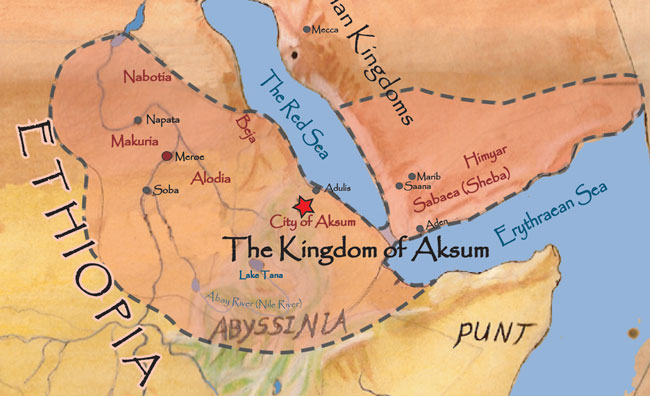 Incredible Human Journey, Episode 1, Arabia Sequence (Eden) https://www.youtube.com/watch?v=YIJeFL6uOqU 1 Like |
| Re: When the Arabian peninsula was Northeast Africa(for The Anthropologist Among Us) by Nobody: 1:27am On Nov 27, 2013 |
Great post here. Will get into it later; I just did a quick perusal. Been a major admirer of Nubia/Kerma/Kush since I stumbled upon its history like seven years ago. 1 Like |
| Re: When the Arabian peninsula was Northeast Africa(for The Anthropologist Among Us) by RandomAfricanAm: 8:22am On Nov 27, 2013 |
This video says of the current Lebanese population "only 27 percent of the population carries the Phoenician gene the rest are a genetic cocktail" I.E most people in modern Lebanon are not genetically representative of the ancient Phoenicians. https://www.youtube.com/watch?v=TCCwqSIpERA Now in this video Spencer wells of the Human Genographic project states that "we are not seeing a significant genetic influence on the coastal populations of the lavent from elsewere they look very similar to the groups we see inland in Syria and jordan" https://www.youtube.com/watch?v=-ZjF5IfuML0 "We're not seeing a significant genetic influence from elsewhere on the coastal population in what was the Levant region," says Wells. "The people are very similar to the groups we see inland in Syria and Jordan, for example, suggesting that there wasn't a huge influx of Sea Peoples or others from outside the area. A cultural shift occurred but not a genetic one. Today's Lebanese, the Phoenicians, and the Canaanites before them are all the same people." - http://ngm.nationalgeographic.com/ngm/0410/feature2/online_extra.html but spencer wells is contradicted by the data from his own research that states "only 27 percent of the population carries the Phoenician gene the rest are a genetic cocktail" Now lets dig into history for some context...
Spencer wells blind spot is that he only looks at one possibility The sea peoples That result extinguishes Wells' theory that the migrating Sea Peoples interbred with the Canaanites to create the Phoenician culture.- http://ngm.nationalgeographic.com/features/world/asia/lebanon/phoenicians-text/5 He also states that only %10-%20 "or even less" of Carthage was from the "middle east" and that the rest were "aboriginal North Africans". But never explores the idea that some of the Phoenicians themselves might have been of the same "genetic stock" as those north Africans in the first place. Egyptians had numerous sites in "cannon land"  ....and the nile valley is also were the berber linguistic group came from. This sounds to me like at some point the Arabian peninsula was overran by "foreigners". Now we know of the Ottoman Turks and their Eastern European, caucus, and Mediterranean slaves and transplants that were moved throughout there empire. [img]http://2.bp..com/_pR-VDlMPyvQ/TJJ4hGeZXyI/AAAAAAAAC1E/_UbxHCeudbI/s1600/osmanli%5B1%5D.gif[/img] (People tend to forget that while the Ottomans took Islam They oppressed Arabs the same as everyone else in there empire. So much so that the Arabs teamed up with the British in WW1 to kick out the ottomans) But what about before that period, around their contemporary times...(See next post) |
| Re: When the Arabian peninsula was Northeast Africa(for The Anthropologist Among Us) by RandomAfricanAm: 1:01am On Dec 08, 2013 |
He also states that only %10-%20 "or even less" of Carthage was from the "middle east" and that the rest were "aboriginal North Africans". But never explores the idea that some of the Phoenicians themselves might have been of the same "genetic stock" as those north Africans in the first place. Egyptians had numerous sites in "cannon land..." Peter van der Veen investigates an Egyptian presence before the time of David Noah Wiener • 02/25/2013 Peter van der Veen augmented a study by Gabriel Barkay on the Egyptian pharaohs’ rule over Bronze Age Jerusalem, uncovering Egyptian statues, architectural elements and texts attesting to their presence in the city. This 13th-century B.C.E. red granite statue depicts an Egyptian queen. The Egyptian statue’s significance went unnoticed for quite some time; uncovered by Arab workmen during the British Mandate, it was brought to a local clergyman’s house before being kept in a scholar’s office in Germany. Credit: R. Müller, Department of Prehistory, University of Mainz. What were Egyptian pharaohs doing in Bronze Age Jerusalem? In a BAR feature 13 years ago,1 Israeli archaeologist Gabriel Barkay investigated evidence of an Egyptian temple in Jerusalem, exposing the “Egyptianizing” of Bronze Age Jerusalem. In the March/April 2013 issue, Peter van der Veen presents new evidence of an Egyptian presence in Bronze Age Jerusalem before David made the city the Israelite capital. In “When Pharaohs Ruled Jerusalem,” Peter van der Veen brings together an array of evidence—including Egyptian statues, stylized architecture and material culture—that points to their presence in the city. But what did the Egyptian pharaohs want with Late Bronze Age Jerusalem? And where were they when David conquered the Jebusite city? The initial study by Gabriel Barkay (which Peter van der Veen refers to as “reminiscent of nothing so much as Sherlock Holmes”) exposed Egyptianizing column capitals, a hieroglyphic stela and two Egyptian-style alabaster vessels that likely served as burial gifts. Peter van der Veen expanded the investigations of Gabriel Barkay to include figurines and Egyptian statues as well as a funerary stela referring to the local “ruler” of Bronze Age Jerusalem. The Egyptian artifacts date to the 13th century B.C.E., during the 19th Egyptian Dynasty that included the reign of Ramesses II. Peter van der Veen writes “Egypt was not new to Canaan in the 19th dynasty … Canaan was in effect an Egyptian province during the 14th century B.C.E.” In the famous Amarna letters, Abdi-Heba, the puppet-king of Jerusalem, proclaims that “the king has placed his name in Jerusalem forever.” While Bronze Age Jerusalem was not situated on Canaanite trade routes, Peter van der Veen notes that it controlled north-south traffic between Hebron and Shechem, as well as east-west traffic from the Via Maris to the King’s Highway. The Egyptians established a garrison at Manahat, just two miles southwest of Bronze Age Jerusalem. It seems that the Egyptian pharaohs of the 19th dynasty used local vassal rulers to run daily affairs in Late Bronze Age Jerusalem, as did their predecessors in the Amarna period. But there is almost no evidence of an Egyptian presence in Jerusalem just prior to David’s conquest, around 1000 B.C.E. The Egyptian pharaohs did not lose interest in the city; the Bible tells us that Shishak sent his army north less than a century after David’s conquest of Jerusalem.2 Peter van der Veen poses the question: “Was David able to conquer Jerusalem (in about 1000 B.C.E.) because it was defended only by the Jebusites/Canaanites, without any Egyptian presence in the city?” -------------------------------------------------------------------------------- Notes 1. Barkay, Gabriel. “What’s an Egyptian Temple Doing in Jerusalem?.” Biblical Archaeology Review, May/Jun 2000, 48-57, 67. 2. Levin, Yigal. “Did Pharaoh Sheshonq Attack Jerusalem?.” Biblical Archaeology Review, Jul/Aug 2012, 42-52, 66. Permalink: http://www.biblicalarchaeology.org/daily/biblical-sites-places/jerusalem/when-egyptian-pharaohs-ruled-bronze-age-jerusalem stine/Israel. |
| Re: When the Arabian peninsula was Northeast Africa(for The Anthropologist Among Us) by RandomAfricanAm: 1:44am On Dec 08, 2013 |
[img]http://egyptianaemporium.files./2013/07/20130709-200648.jpg[/img] France24 Unique Egyptian sphinx unearthed in north Israel AFP - Part of an ancient Egyptian king's unique sphinx was unveiled at a dig in northern Israel on Tuesday, with researchers struggling to understand just how the unexpected find ended up there. The broken granite sphinx statue -- including the paws and some of the mythical creature's forearms -- displayed at Tel Hazor archaeological site in Israel's Galilee, is the first such find in the region. Its discovery also marks the first time ever that researchers have found a statue dedicated to Egyptian ruler Mycerinus who ruled circa 2,500 BC and was builder of one of the three Giza pyramids, an expert said. "This is the only monumental Egyptian statue ever found in the Levant - today's Israel, Lebanon, Syria," Amnon Ben-Tor, an archaeology professor at the Hebrew University in charge of the Tel Hazor dig, told AFP. "It is also the only sphinx of this particular king known, not even in Egypt was a sphinx of that particular king found." Ben-Tor said that besides Mycerinus's name, carved in hieroglyphics between the forearms, there are symbols reading "beloved by the divine souls of Heliopolis". "This is the temple in which the sphinx was originally placed," Ben-Tor said of Heliopolis, an ancient city which lies north of today's Cairo. Tel Hazor, which Ben-Tor calls "the most important archaeological site in this country," was the capital of southern Canaan, founded circa 2,700 BC and at its peak covering approximately 200 acres and home to some 20,000 Canaanites. It was destroyed in the 13th century BC. "Following a gap of some 150 years, it was resettled in the 11th century BC by the Israelites, who continuously occupied it until 732 BC," when it was destroyed by the Asyrians, Ben-Tor said. He said the find was approximately 50 centimetres (20 inches) long, and estimated the entire statue was 150 centimetres (60 inches) long and half a metre (20 inches) high". How, when and why it reached Tel Hazor remains a mystery. "That it arrived in the days of Mycerinus himself is unlikely, since there were absolutely no relations between Egypt and this part of the world then," said Ben-Tor. "Egypt maintained relations with Lebanon, especially via the ancient port of Byblos, to import cedar wood via the Mediterranean, so they skipped" today's northern Israel, he said. Another option is that the statue was part of the plunders of the Canaanites, who in the late 17th and early 16th century BC ruled lower Egypt, the expert said. "Egyptian records tell us that those foreign rulers... plundered and desecrated the local temples and did all kinds of terrible things, and it is possible that some of this looting included a statue like this one". But to Ben-Tor the most likely way the sphinx reached Tel Hazor is in the form of a gift sent by a later Egyptian ruler. "The third option is that it arrived in Hazor some time after the New Kingdom started in 1,550 BC, during which Egypt ruled Canaan, and maintained close relations with the local rulers, who were left on their thrones," he said. "In such a case it's possible the statue was sent by the Egyptian ruler to king of Hazor, the most important ruler in this region." Shlomit Blecher, who manages the Selz Foundation Hazor Excavations in Memory of Yigael Yadin, was the archaeologist who actually unearthed the finding in August 2012. The statue's incrustation was meticulously removed over a period of many months by the excavation's restorer, before the intricate carvings and hieroglyphics were fully visible. "It was the last hour of the last day of the dig," she told AFP of the moment of the find. "We all leapt with joy and happiness, everyone was thrilled." "We hope the other pieces are here and that we find them in the near days," she said. Ben-Dor said the statue was most likely deliberately broken by new occupiers at Tel Hazor in an act of defiance to the old rule. Finding the sphinx was "unexpected," said Ben-Tor, "but fits" archaeological facts and findings. "When you're in a bank, you find money," he said. To Ben-Tor, however, the true coveted find would be archives buried somewhere on Tel Hazor that could serve as an inventory to the ancient city's content. "I know there are two archives," he said. "We already have 18 documents from two periods, the 17th and 14th century BC. If I found those archives, people would come running here."  |
| Re: When the Arabian peninsula was Northeast Africa(for The Anthropologist Among Us) by Garaad: 9:09pm On Dec 12, 2013 |
Yemen was actually a colony of Ethiopia during the time before Prophet Muhammad. Its the reason why Yemen is culturally more like East Africa than the rest of the Arab world. If you go there you'll see they dress and act like Somalis rather than Arabs. Most people think this is Somalis copying Arab culture but its really the other way around. Its Yemenis that are still influenced by East African culture since they were a colony. 1 Like |
| Re: When the Arabian peninsula was Northeast Africa(for The Anthropologist Among Us) by RandomAfricanAm: 1:09pm On Dec 14, 2013 |
^ Bump |
| Re: When the Arabian peninsula was Northeast Africa(for The Anthropologist Among Us) by TonySpike: 3:23pm On Dec 22, 2013 |
Hey RandomAfrican, I've got some questions to ask you: 1. Are you the same person as KidStranglehold? 2. Do you think there's a slight possibility of cultural and language propagation of Kemetic culture into West Africa between 1000 BC and 1 AD? On a probabilistic scale, what is your opinion? 3. I have read some random publications on ancient Phoenicians sailing as far as West Africa on the seas. Do you think there was/were Phoenician colon(ies) along the West African coasts in ancient times? 4. Have you read about the Lemba Tribe of Zimbabwe and their LEVANT haplotype discovery? If so, by what means (transportation) do you think they got to Southern Africa? 5. I saw your comments on a thread on Yoruba "ADO" origin. There have been a fierce debate on the origin of the cultural, traditional and religious fragments in Yoruba here on Nairaland. I'm of the school of thought that the Yoruba antiquity is derived from a breakaway group in Kemet before 1 AD. What is your opinion on this? Thanks. By the way, I'm just a freelance enthusiast/researcher on Yoruba origins. All my questions above are burning issues on my mind now... |
| Re: When the Arabian peninsula was Northeast Africa(for The Anthropologist Among Us) by RandomAfricanAm: 6:58pm On Dec 23, 2013 |
Hey Tony, sorry I saw this post and said to myself I'd reply in the morning then forgot about it. 1. No I think kid only goes by kidstranglehold & stranglehold(Given that it's the holidays he's probably with his family right now) 2. Slight possibility ...sure. Just know that possibility and proof are to different things. Possibilities are what you follow till you find proof. In scientific parlance "possibility" is commonly referred to as hypothesis. 3. I have no reason to believe there were any colonies along the west African coast.(at most there might have been trade but I have no evidence) 4. Yes I'm familiar with them. My understanding is they claim to have come from southern Yemen so boat would be the obvious thought. There were trade relations between the Swahili coast and the Great Zimbabwe area so I could see them following trade routs inland. [img]http://3.bp..com/-O3_4vA7z3JI/UIVzPXfh8vI/AAAAAAAAEM0/NigJJpKe1Xw/s1600/Map_of_the_Periplus.jpg[/img] http://upload.wikimedia.org/wikipedia/commons/a/a5/Map_of_the_Periplus_of_the_Erythraean_Sea.jpg As far as the land routs my understanding is that A. Abyssinia was a Hebrew country before converting to Christianity. B. Abyssinia invaded Yeman because Christians were being persecuted by Hebrews. C. Before the founding of islam there were Hebrews in Somalia who are now an outcast caste(the 'Yibir') in Somali society. http://books.google.com/books?id=gYcv2qE1pH8C&lpg=PT38&dq=somali%20outcast%20jewish&pg=PT38#v=onepage&q=somali%20outcast%20jewish&f=false Which points to there being Hebrews around the coast of north east Africa I could easily see them walking from Somalia to Kenya then following trade routes inland. (Note: I'd suggest you check the dates on everything I said to see which scenario line up date wise) 5. My stance on the Yoruba stems from my over arching stance on all Africans. Which is the commonality seen in Africans stem from a common habitat and cultural relations in the green Sahara. After the Sahara dried out this common culture spread out west, south, and east with trade relations being kept by way of the Sahel and Nile(Blue & White). Around 1000BC both the Bantu & Tamazight "People of the green Sahara" migrated to the north and south of the continent. Around 800-1200 AD Muslim incursions pushed those "People of the green Sahara" who didn't want to convert down the Niger, Volta, & Lake chad rivers inland. This is around the time we find that the Akan, Fon, Edo, Yoruba, Igbo, Bamaleki, Congo, Etc come on the scene. Now that's not set in stone but that's my political (hypothesis / starting point) when talking migrations and the founding of the "forest kingdoms/empires". Note: My base stance isn't based on a particular affinity for any particular people it's based on looking at the overarching migration and geological patterns. After that then I look at specific groups of people. I feel that allows me to cut out any obviously contradictory scenarios. Good luck on the research!!! |
| Re: When the Arabian peninsula was Northeast Africa(for The Anthropologist Among Us) by Nobody: 6:58am On Dec 25, 2013 |
Garaad: Yemen was actually a colony of Ethiopia during the time before Prophet Muhammad. Its the reason why Yemen is culturally more like East Africa than the rest of the Arab world. If you go there you'll see they dress and act like Somalis rather than Arabs. Most people think this is Somalis copying Arab culture but its really the other way around. Its Yemenis that are still influenced by East African culture since they were a colony. It was recently discovered that the Khat plant was taken to Yemen during that era by Ethiopians. Today Yemenis chew more Khat than most East Africans, heck even the young girls and women chew that stuff. Ethiopians ruled Yemen when the house of Solomons(Tigray) ruled Axum, the Tigray were toppled by the Emperor Yohannes I who was of Amharic/Oromo origin hence the anmosity between Tigrayans and Amharas. He created the Abyssinian kingdom. As for Yemen, Aden could almost pass as a Somali city considering the amount of ethnic Somalis living there for the last few hundred years. I'd say at least half of the one million Somalis in Yemen live in Aden and it's surrounding areas. |
| Re: When the Arabian peninsula was Northeast Africa(for The Anthropologist Among Us) by FTRuutz: 7:29pm On Jan 07, 2014 |
The historian Taticus mentioned the people of western Judea of his time being a race of Ethiopians. Ethiopians referred to all dark skinned african people as Aetiops mention burnt face and others referred to Ethiopians and Egyptians as wolly haired, thick lipped, flat nosed and burnt of skin , not the brown skin curly soft haired, thin nose Ethiopians of today but more like those Hamar people of the Omo valley |
| Re: When the Arabian peninsula was Northeast Africa(for The Anthropologist Among Us) by TonySpike: 4:15pm On Oct 07, 2014 |
Nice topic... |
(1) (Reply)
Why Do Black People Walk With A Limp? / Calabar Names / Learn French Live On Nairaland!!!
(Go Up)
| Sections: politics (1) business autos (1) jobs (1) career education (1) romance computers phones travel sports fashion health religion celebs tv-movies music-radio literature webmasters programming techmarket Links: (1) (2) (3) (4) (5) (6) (7) (8) (9) (10) Nairaland - Copyright © 2005 - 2024 Oluwaseun Osewa. All rights reserved. See How To Advertise. 114 |